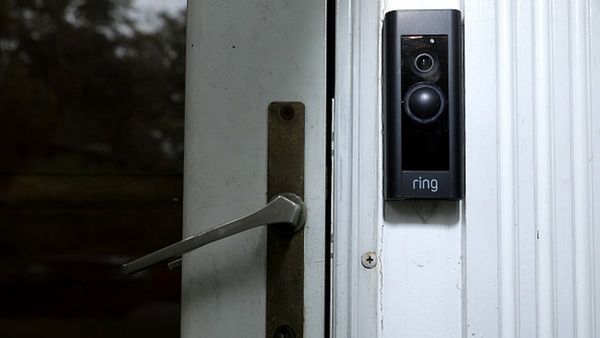
The basic issues in labor disputes don’t change much. Here in 2023, as in years past, they hit familiar notes: fair pay, respect in the workplace, pushback against corporations determined to wring droplets of extra profit and hike stock prices by supersizing the jobs workers are asked to do.
Those principles have been the foundation of protests by nurses and health care workers over just the past couple of years, as COVID exposed hospitals’ woeful lack of staffing and equipment. They describe the ongoing struggle by California’s service industry workers — restaurant, hotel, convention center — for livable wages and safe working conditions.
And they are at the root of the most recent job action, the strike by the Writers Guild of America (WGA) that began May 2.
So what’s different this time around?
Alas: It’s Hollywood itself.
The Writers Guild of America says that, over the past decade, median weekly writer-producer pay has declined 4%.
There aren’t many times when adding the word “Hollywood” to a sentence makes it worse, but this is one of them. It distracts from the point of the writers’ action by setting the dispute inside a fantasy factory, the miniverse in which movies, television and streaming shows are produced and sent out into the world.
A Hollywood strike doesn’t sound real — or, if real, it doesn’t sound urgent. But this is a legitimate action, meant to call attention to legitimate labor issues. And when you strip away the patina of the industry itself, those issues are utterly common: Workers are getting paid less and asked to do more, while their employers make whopping profits but decide those aren’t enough.
There’s nothing flashy about it. As any writer would tell you, it isn’t even a new story.
On the day the strike began, the WGA made public a detailed list of its proposals for a new contract with the Alliance of Motion Picture and Television Producers. The AMPTP is the broad consortium of movie and television studios and includes industry powerhouses like Paramount, Sony, Universal and Disney, all the networks, and the rising forces of the business: streaming services led by Netflix, Amazon and Apple TV+.
The WGA’s list made it clear how far apart the sides were in bargaining, and nothing has changed in the week-plus since writers began walking pickets. By the union’s accounting, its proposals would gain writers approximately $429 million per year, while the AMPTP’s proposals would amount to $86 million per. That’s quite a gulf.
More significant, though, is what’s found in the fine details. Nearly half of the AMPTP’s suggested increase is simply in the form of raised minimum wages — the very least that studios can be made to pay. That matters because the studios are paying the minimum to a higher percentage of writers than at any time in recent history.
The WGA says that, over the past decade, median weekly writer-producer pay has declined 4%. Factoring in inflation, the reduction is 23%.
That’s not Hollywood talk. It is common to workers in a multitude of industries, and it is the result of a pretty generic tactic: companies attempting to shift the highest number of workers possible to the lowest wages possible. While the raw dollars involved may be higher in TV/film than in other industries, so is the cost of living; the median list price for a house in Los Angeles, where most writers need to live, was $1.1 million in April, according to Realtor.com.
The vote in favor of striking was 98%, and the net effect was to grind the fantasy factory to a halt.
There are other issues that, while cloaked in show business jargon, are old-school in nature. Where “writers’ rooms” of between six and 12 writers are traditionally staffed in order to produce a network show for a season, streaming services are increasingly using “mini-rooms” of just a couple of writers, who are often asked to sketch out or complete a season’s worth of episodes for a series that hasn’t even been picked up yet. That is a full staff’s worth of work.
The explosion in the use of mini-rooms over the past decade is a source of concern for writers, as is the fact that most streaming series come in at eight or 10 episodes per season, meaning a few months’ work, versus 20 to 24 for network shows, which are usually 10-month assignments. That, too, matters in a business where a writer may go long stretches between series — months or years.
And the WGA’s request to set limits on the use of AI in the creative process — to prohibit AI-generated primary scripts, for example — has been met with stony silence from the industry, a chilling suggestion that the studios have no interest in governing their ability to, potentially, replace workers altogether.
Boiled down: Writers are losing ground financially; companies are trying to get them to do more work for less money; employers don’t want to talk about the future of work.
That is a universal language of labor.
Several factors make the writers’ strike appear different from other job actions. One, of course, is that writers aren’t negotiating for 40 hours a week. The very nature of their business is cyclical work in unpredictable amounts — one reason why the union fought so hard in previous labor agreements for, among other things, health care benefits that are easier to attain.
Another factor is scale. While the WGA’s $429 million proposed gain sounds like a lot, it’s worth noting that, by the union’s detailed accounting, industry profits have landed in the $28 billion to $30 billion range each year from 2017-2021. Netflix, the industry’s designated disruptor because of its streaming success, has led the way, reporting $6 billion in profit in 2021 alone.
But the biggest difference in this Hollywood story may be the union itself. The WGA is not only powerful, with a membership that includes virtually every working writer in the industry, it is cohesive. The vote in favor of striking was 98%, and the net effect was to grind the fantasy factory to a halt: no scripts, no rewrites, no productions. Late-night talk shows, so dependent on writers’ rooms for their monologues and segments, went dark immediately.
Hollywood studios have historically disdained their content creators, one reason why unionization among the industry’s writers goes back more than a century.
Though it may play against type, Hollywood is a union town. Almost every job, from director to electrician to food service worker, is a union-repped job. And the AMPTP is facing two important upcoming negotiations beyond the writers: the Directors Guild of America, beginning this week, and SAG-AFTRA (which represents performers) later in the summer. It has no choice but to deal with the WGA, sooner if not later.
The studios have historically disdained their content creators, one reason why unionization among the industry’s writers goes back more than a century. As the Los Angeles Times recently noted, Irving Thalberg, who helped create MGM Studios and became its head producer at the age of 26 in 1925, once said, “What’s all this business about being a writer? It’s just putting one word after another.”
In truth, writers are the genesis of most of what the studios produce. Here in 2023, they are also well-organized workers, part of a union that has struck eight times since the 1950s to obtain fair wages and conditions.
In that respect, they hold important common ground with nurses, hotel workers, food service employees and others, and their ability to achieve a just deal with massive, bottom-line oriented corporations should be watched closely. The Hollywood sign, after all, is just a sign. This is a labor negotiation.







